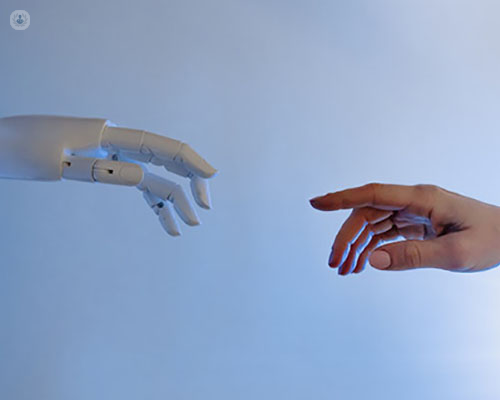Advancements in knee replacement: Robotic-assisted precision and improved outcomes
Escrito por:In his latest online article, Mr Tahir Mahmud gives us his insights into robotic assisted knee replacement. He talks about the key benefits and advantages, the specific criteria and recovery and rehabilitation.

What are the key benefits and advantages of robotic assisted knee replacement compared to a traditional technique?
The potential advantages of a robotic assisted knee replacement are that the surgeon is able to plan the operation before the patient even gets to the operating theatre. This is done by obtaining a CT, which is a special high-detailed x-ray of the patient from their hip to their ankle, which helps us ascertain the anatomy of the knee joint and the alignment for that particular patient.
That information is then used to upload onto the robot, which essentially is a mobile arm with either a saw blade or a high-speed burr attached to the end, which helps us to very precisely remove bone from both the femur and the tibia, or the thigh bone and the leg bone, in order to implant the prosthesis, which are the knee replacement components, so that when the patient stands up, we're able to achieve the optimum alignment, particularly for that patient.
The robot is also able to give the surgeon real-time information on the ligament tension around the knee, which enables us to balance the knee. Ultimately, having excellent alignment and good ligament balancing will potentially allow the knee to feel as normal as possible. These are the potential advantages over a standard non-robotic knee replacement treatment.
What specific patient criteria makes someone an ideal candidate for this kind of procedure?
Most patients with osteoarthritis of their knee, whether it's involving one compartment or one part of the knee or more than one part of the knee, will be suitable for either a robotic assisted partial knee replacement or potentially a total knee replacement. The robotic assisted procedure enables the surgeon to perform both with routine knee replacement procedures and potentially even more complex procedures, treating patients with more severe deformities off their knee. So essentially most patients who have osteoarthritis and who need a total knee replacement or partial knee replacement will be suitable candidates for the robotic assisted procedure.
What can patients expect during recovery and rehabilitation process after the robotic assisted knee replacement?
Following a robotic assisted knee replacement, the initial recovery is a lot quicker than compared with standard knee replacement techniques. This is usually due to the fact that there is less swelling, and it is the swelling that generally contributes significantly to pain and stiffness after the procedure. With the robotic assisted knee replacement, it's not unusual to see patients coming off their crutches and coming off their painkillers quicker than patients who are undergoing non-robotic knee replacement procedures. Generally, by three to four months after surgery, patients tend to get back to a reasonable level of activity. After all, the recovery following any form of neuroplastic surgery is usually around 12 months.
How does this kind of procedure improve surgical outcomes for the patients?
A concern associated with knee replacement surgery, as evident from online literature, is the possibility of dissatisfaction among approximately 15 to 20 percent of patients undergoing the procedure. That can mean there's anywhere between 80 to 85 percent of patients who are really happy with their total knee replacement.
Some of the reasons for an unhappy patient after a total knee replacement procedure can be ongoing pain or stiffness or pain and stiffness. Some of these problems are due to malposition of the implants, which can lead to reduced range of motion or stiffness in the knee or issues that can affect how the kneecap runs up and down the knee replacement.
By using a robotic assisted technique, there is greater accuracy in execution of the operation which improves the likelihood of getting better implant or prosthesis orientation and better soft tissue balancing around the knee, which will also improve how the kneecap bone moves up and down the knee as the knee goes from a straight to a bent position. These factors can help reduce the number of unhappy patients.
Mr Tahir Mahmud is a distinguished orthopaedic surgeon with over 20 years of experience. You can schedule an appointment with Mr Mahmud on his Top Doctors profile.


